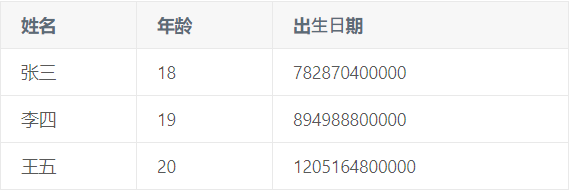首先制定表格API。表格分为表头thead和数据tbody,所以props也定义为两部分:
-
columns: 列配置Array,每一列均为Object:
- title: 列文字
- key: 对应列内容字段名称
- render: 渲染函数
- slot:插槽名称
-
data: 数据内容Array
在components目录中新建table目录,创建table.vue文件:
<template>
<table>
<thead>
<th v-for="(col, index) in columns" :key="index">
{{ col.title }}
</thead>
<tbody>
<tr v-for="(row, index) in data" :key="index">
<td v-for="(col, idx) in columns" :key="idx">
{{ row[col.key] }}
</tbody>
</table>
</template>
<script>
export default {
props: {
columns: {
type: Array,
default: () => []
data: {
type: Array,
default: () => []
</script>
<style>
table {
width: 100%;
border-collapse: collapse;
border-spacing: 0;
empty-cells: show;
border: 1px solid #e9e9e9;
table th {
background: #f7f7f7;
color: #5c6b77;
font-weight: 600;
white-space: nowrap;
table td,
table th {
padding: 8px 16px;
border: 1px solid #e9e9e9;
text-align: left;
</style>
在page目录下新建table.vue页面
<template>
<table-render :columns="columns" :data="data"></table-render>
</div>
</template>
<script>
import TableRender from "../components/table/table.vue";
export default {
components: { TableRender },
data() {
return {
columns: [
title: "姓名",
key: "name",
title: "年龄",
key: "age",
title: "出⽣⽇期",
key: "birthday",
data: [
name: "张三",
age: 18,
birthday: "782870400000",
name: "李四",
age: 19,
birthday: "894988800000",
name: "王五",
age: 20,
birthday: "1205164800000",
</script>
效果如下:

这里日期这一栏显示时间戳,计划在columns中如下使用render
title: "出⽣⽇期",
key: "birthday",
render: (h, { row,index, column }) => {
const date = new Date(parseInt(row.birthday));
const year = date.getFullYear();
const month = date.getMonth() + 1;
const day = date.getDate();
const birthday = `${year}-${month}- ${day}`;
return h("span", birthday);
组件中table修改如下: 其中Render组件就是打算用render函数渲染的部分,它把当前所属列的数据全部通过props传了进去。
<tbody>
<tr v-for="(row, index) in data" :key="index">
<td v-for="(col, idx) in columns" :key="idx">
<template v-if="col.render">
<Render
:row="row"
:column="col"
:index="index"
:render="col.render"
></Render>
</template>
<template v-else>{{ row[col.key] }} </template>
</tbody>
import Render from "./render.js";
export default {
components: { Render }
render.js中代码如下:这里用props接受了外面传进来的参数,render函数真正渲染了页面
注意:从始至终只有render.js中的render函数是vue中真正渲染页面的render函数,columns中只是碰巧定义了render字段,它只是一个普通函数。
export default {
functional: true,
porps: {
row: Object,
column: Object,
index: Number,
render: Function
render: (h, ctx) => {
const params = {
row: ctx.props.row,
column: ctx.props.column,
index: ctx.props.index
return ctx.props.render(h, params);
slot-scope就是写slot时往父级传递参数,在写table组件时添加一列slot标签,同时加上row,column,index属性,把当前列信息传递出去,在外面使用的时候就能拿到该列信息对应渲染自己想要显示的数据
组件代码如下:
<template v-if="'col.render">
<Render
:row="row"
:column="col"
:index="index"
:render="col.render"
></Render>
</template>
<template v-else-if="col.slot">
:row="row"
:column="col"
:index="index"
:name="col.slot"
></slot>
</template>
<template v-else>{{ row[col.key] }} </template>
page使用代码如下:这里可以拿到当前列所有信息,可以任意处理
<table-render :columns="columns" :data="data">
<template slot-scope="{ row, index, column }" slot="name">
{{ row.name }}
</template>
</table-render>
待续。。。
一.slot
插槽,也就是slot,是组件的一块HTML模板,这块模板显示不显示、以及怎样显示由父组件来决定。值得注意的是:内容要写在父组件中,然后分给需要的子组件,当slot多个时,可以通过name来加以区分,这就是所谓的具名插槽。
这是父组件
实践slot
实践具名slot
这是子组件
二.slot-scope
slot-scope就是作用域插槽。官方叫它作用域插槽,实际上,对比具名插槽,我们可以叫它带数据的插槽。具名插槽在组件的templat
vue中的插槽有三种:单个插槽、具名插槽、作用域插槽,这个在官网上能看到
(https://cn.vuejs.org/v2/guide/components.html#单个插槽)
作用域插槽简单来说就是父组件只管显示样式,数据由子组件来提供。比如上面的代码,el-table-column内的template是传递给其内部solt的显示内容,但是scope的值是由el-table-column内部solt绑定的数据返回的。这个数据具体是什么由el-table-column中指定,类似:
export default {
渲染函数基础节点、树以及虚拟DOM虚拟DOMcreateElement参数深入数据对象完整示例约束
Vue 推荐在绝大多数情况下使用模板来创建你的 HTML。然而在一些场景中,你确实需要 JavaScript 的完全编程的能力。这时你可以用渲染函数,它比模板更接近编译器。
让我们深入一个简单的例子,这个例子里 render 函数很实用。假设我们要生成一些带锚点的标题:
<h1&...
开发中总是会遇到各种UI设计的图表,最近也一直“沉浸”在负责的两个专门做数据可视化的项目中,其中有个表格很好玩,效果如下图:(也不知道会不会压缩)
本项目主要使用VUE、Echarts、Element UI,来吧,直接开始了。
第一步:咱们需要重新封装table组件。
<el-table :data="tableData">
<el-table-column
v-for="(item, index) of tableColumns"
:key="index"
在这个示例代码中,我们在表头中定义了两列:姓名和操作。对于“操作”列,我们使用了 scopedSlots 来定义一个名为 operation 的插槽,用于自定义该列的内容。在插槽中,我们根据当前行的展开状态来显示不同的按钮。如果当前行已展开,则显示“Close”按钮。在 Ant Design Vue 中,可以使用 a-table 组件来创建表格,并且可以使用 expand-row 属性来自定义展开/折叠行。为了在表头中添加一个自定义的“+”按钮,可以在表头中使用 slot 插槽来自定义表头的列。
form-create 是一个可以通过 JSON 生成具有动态渲染、数据收集、验证和提交功能的表单生成器。并且支持生成任何 Vue 组件。结合内置17种常用表单组件和自定义组件,再复杂的表单都可以轻松搞定。
文档 | github
自定义组件
可生成任何Vue组件
自带数据验...
